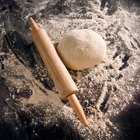
You've seen frozen bread dough, pizza dough and roll dough in the grocery store freezer section. If bread manufacturers can freeze unbaked bread dough, you can certainly do it at home too. Unlike quick breads and muffins that contain leavening agents that need immediate baking, yeast doughs can safely hibernate in the freezer for several weeks. The yeast lies dormant, just waiting for warmth to bring it back to life.
The Dinner Rush
Bread purchased at a store can never compare to homemade bread, but most breads take two or three hours to make from start to finish, including one or two rise times and baking. Freezing raw bread dough cuts that time in half, so you can have homemade bread even on a busy weeknight. Freezing works for any type of bread dough, but pizza doughs, roll recipes and breads that need only one rising thaw and bake up fastest.
Into the Freezer
If you're making a dough that needs only one rising, such as a pizza dough, shape the dough into a disc. Toss the dough into a lightly oiled zip-top plastic freezer bag and freeze it. To thaw the dough and let it raise, store the bag in the refrigerator overnight or place it on the counter, which can take several hours. For doughs that need two risings, let the dough rise once immediately after you make it. Punch the dough down and shape it into a disc. Put the disc in an oiled plastic bag and freeze it. To thaw it, place it in the refrigerator overnight or set it on the countertop for several hours. Once the bread has come to room temperature and risen, bake it as you normally would.
Safety First
Bread doesn't have the potential for food poisoning associated with meat, eggs and dairy products, but it can develop mold if improperly stored. For the best quality, write the date on the plastic bag before you freeze the bread dough. Use the bread dough within four weeks. Freezing bread dough at zero degrees Fahrenheit will keep it safe indefinitely, but quality will decline after this time. Discard any dough that has off odors or shows signs of mold growth.
Tips for Success
Although heat can kill yeast outright, freezing it merely slows it down a bit. To ensure a good rise, add twice as much yeast as the recipe calls for if you plan to freeze the dough. If you're making rolls, shape the dough into balls and place the balls on a baking sheet. Put the baking sheet in the freezer and freeze the balls for 20 to 30 minutes or until they're firm, but not frozen solid. At this point, transfer the balls to a plastic freezer bag. Pull out just the number of rolls you need for dinner and thaw them on a greased baking sheet. They'll thaw quickly without the work of shaping the dough.
Related Articles

How to Preserve Dough That Has Risen

Can I Make Doughnuts From Frozen Yeast ...

How to Freeze Brioche

What to Do With Pizza Dough When You're ...
How to Keep Indian Fry Bread Fresh

Can You Refrigerate Homemade Yeast ...

Quick Method for Thawing Frozen Bread ...
How to Freeze a Baguette

Does Bread Expire?

Can Crescent Rolls Expire?

Can I Freeze Unbaked Biscuits?

How to Make Bread Sticks Out of Pizza ...

Do You Have to Allow Pizza Dough to ...
How to Keep Crusty Italian Bread Soft

Can I Make Monkey Bread the Night ...
Can You Refrigerate Homemade Yeast ...

How Long Does Banana Bread Stay Fresh?

How to Freeze a Loaf of Bread

How to Keep Sandwich Bread Fresh All ...

How to Bake Frozen Spanakopita
References
Writer Bio
Julie Christensen is a food writer, caterer, and mom-chef. She's the creator of MarmaladeMom.org, dedicated to family fun and delicious food, and released a book titled "More Than Pot Roast: Fast, Fresh Slow Cooker Recipes."
Photo Credits
Jupiterimages/Photos.com/Getty Images